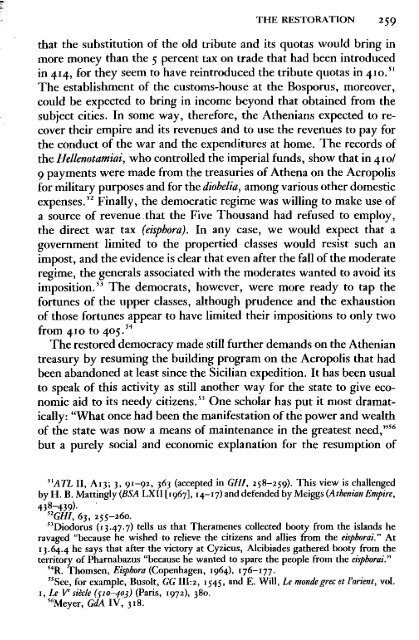The Fall of the Athenian Empire-(A New History of the Peloponnesian War) Donald Kagan - (1987)
MACEDONIA is GREECE and will always be GREECE- (if they are desperate to steal a name, Monkeydonkeys suits them just fine) ΚΑΤΩ Η ΣΥΓΚΥΒΕΡΝΗΣΗ ΤΩΝ ΠΡΟΔΟΤΩΝ!!! Strabo – “Geography” “There remain of Europe, first, Macedonia and the parts of Thrace that are contiguous to it and extend as far as Byzantium; secondly, Greece; and thirdly, the islands that are close by. Macedonia, of course, is a part of Greece, yet now, since I am following the nature and shape of the places geographically, I have decided to classify it apart from the rest of Greece and to join it with that part of Thrace which borders on it and extends as far as the mouth of the Euxine and the Propontis. Then, a little further on, Strabo mentions Cypsela and the Hebrus River, and also describes a sort of parallelogram in which the whole of Macedonia lies.” (Strab. 7.fragments.9) ΚΚΕ, ΚΝΕ, ΟΝΝΕΔ, ΑΓΟΡΑ,ΕΚΚΛΗΣΙΑ,ΝΕΑ,ΦΩΝΗ,ΦΕΚ,ΝΟΜΟΣ,LIFO,MACEDONIA, ALEXANDER, GREECE,IKEA
MACEDONIA is GREECE and will always be GREECE- (if they are desperate to steal a name, Monkeydonkeys suits them just fine)
ΚΑΤΩ Η ΣΥΓΚΥΒΕΡΝΗΣΗ ΤΩΝ ΠΡΟΔΟΤΩΝ!!!
Strabo – “Geography”
“There remain of Europe, first, Macedonia and the parts of Thrace that are contiguous to it and extend as far as Byzantium; secondly, Greece; and thirdly, the islands that are close by. Macedonia, of course, is a part of Greece, yet now, since I am following the nature and shape of the places geographically, I have decided to classify it apart from the rest of Greece and to join it with that part of Thrace which borders on it and extends as far as the mouth of the Euxine and the Propontis. Then, a little further on, Strabo mentions Cypsela and the Hebrus River, and also describes a sort of parallelogram in which the whole of Macedonia lies.”
(Strab. 7.fragments.9)
ΚΚΕ, ΚΝΕ, ΟΝΝΕΔ, ΑΓΟΡΑ,ΕΚΚΛΗΣΙΑ,ΝΕΑ,ΦΩΝΗ,ΦΕΚ,ΝΟΜΟΣ,LIFO,MACEDONIA, ALEXANDER, GREECE,IKEA
You also want an ePaper? Increase the reach of your titles
YUMPU automatically turns print PDFs into web optimized ePapers that Google loves.
THE RESTORATION 261<br />
enment, and <strong>the</strong> questioning <strong>of</strong> tradition. <strong>The</strong> experience <strong>of</strong> war, pestilence,<br />
and defeat had produced a sobering response. It was <strong>the</strong> upper<br />
class that studied with and supported <strong>the</strong> sophists and scientists; <strong>the</strong><br />
average man inclined more to a return to traditional religion, ideas,<br />
and values and, even beyond, toward irrationalism. <strong>The</strong> war years<br />
saw <strong>the</strong> introduction into A<strong>the</strong>ns <strong>of</strong> mystical and orgiastic foreign<br />
deities from Thrace and <strong>the</strong> east. At <strong>the</strong> very time that <strong>the</strong> rational<br />
and scientific Hippocratic school <strong>of</strong> medicine was at its height on <strong>the</strong><br />
island <strong>of</strong> Cos, <strong>the</strong> A<strong>the</strong>nians imported from Epidaurus <strong>the</strong> cult <strong>of</strong><br />
Asclepius, <strong>the</strong> god represented by a serpent, who cured by miracles.<br />
"This diversion <strong>of</strong> religious feelings towards foreign forms in which<br />
could be seen <strong>the</strong> resurgence <strong>of</strong> irrational, 'primitive,' aspirations such<br />
as <strong>the</strong> archaic period had known at <strong>the</strong> time <strong>of</strong> <strong>the</strong> rise <strong>of</strong> Dionysism<br />
or <strong>of</strong> Orphism, went far beyond, in <strong>the</strong> direction <strong>of</strong> regression, <strong>the</strong><br />
conservative reaction <strong>of</strong> civic religion. " 62<br />
Such a movement seems to provide a plausible background for <strong>the</strong><br />
restored democracy's decision to complete <strong>the</strong> construction, begun<br />
after <strong>the</strong> Peace <strong>of</strong> Nicias, <strong>of</strong> <strong>the</strong> temple to A<strong>the</strong>na Polias. In that form,<br />
as <strong>the</strong> patron goddess <strong>of</strong> <strong>the</strong> city, protectress <strong>of</strong> <strong>the</strong> Acropolis itself,<br />
which was <strong>the</strong> earliest location <strong>of</strong> A<strong>the</strong>ns, she was <strong>the</strong> oldest representation<br />
<strong>of</strong> <strong>the</strong> state cult. Her statue, which received <strong>the</strong> sacred<br />
garment at each Pana<strong>the</strong>naic festival, had sat in <strong>the</strong> earliest temple on<br />
<strong>the</strong> Acropolis, which was destroyed by <strong>the</strong> Persians and never rebuilt.<br />
<strong>The</strong> architects who planned <strong>the</strong> new structure were given a most<br />
difficult assignment.<br />
<strong>The</strong> area which <strong>the</strong> Erech<strong>the</strong>ion eventually occupied includes <strong>the</strong> most<br />
ancient shrines <strong>of</strong> <strong>the</strong> Acropolis, sites connected with fertility cults, chthonic<br />
deities, and hero cults whose origins stretched into <strong>the</strong> remote Bronze Age.<br />
Here were <strong>the</strong> tombs <strong>of</strong> Kekrops, Erech<strong>the</strong>us, and Bootes, early kings <strong>of</strong><br />
A<strong>the</strong>ns; <strong>the</strong> miraculous olive tree <strong>of</strong> A<strong>the</strong>na; <strong>the</strong> trident mark and saline springs<br />
left by Poseidon; <strong>the</strong> crevice in which <strong>the</strong> child god Erechthonios guarded<br />
<strong>the</strong> Acropolis in serpent form; a-sanctuary <strong>of</strong> Pandrosus, <strong>the</strong> "moistener <strong>of</strong><br />
all," one <strong>of</strong> <strong>the</strong> three daughters <strong>of</strong> Kekrops who went mad and jumped from<br />
<strong>the</strong> Acropolis when <strong>the</strong>y beheld Erechthonios in <strong>the</strong> form <strong>of</strong> a snake-legged<br />
child; and o<strong>the</strong>r shrines as well. 63<br />
<strong>The</strong> completion <strong>of</strong> <strong>the</strong> Erech<strong>the</strong>um, <strong>the</strong>refore, was an act <strong>of</strong> civic piety,<br />
traditional in its intention, like <strong>the</strong> publication <strong>of</strong> <strong>the</strong> ancient laws <strong>of</strong><br />
62<br />
Will, Le mondegrec, 615-616.<br />
6JJ. J. Pollitt, Art and Experience in Classical Greece (Cambridge, 1972), IJ2-IH.

















